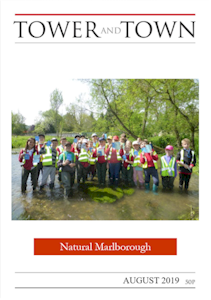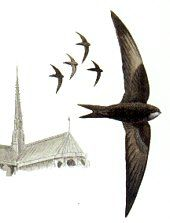

Tower and Town, August 2019 (view the full edition) (view the full edition)Wildlife RamblesScreeching Swifts
At this time of year, one of the most visible and audible birds is the swift, parties of which screech loudly as they perform aerial acrobatics overhead. Almost pure black, with long, swept-back wings, their appearance was described beautifully by Edward Thomas in his poem "Haymaking" - "As if the bow had flown off with the arrow". Swifts arrive from Africa in mid-May and they'll be gone by mid-August. Their scientific name, Apus, suggests, incorrectly, that they are footless. In heraldry, swifts were used as a symbol for the fourth son of a household - a hapless creature unable to plant his feet on the land. A common misconception is that swifts and swallows are closely related; in fact, the nearest relatives of the swifts are the tropical hummingbirds. Feeding on insects caught on the wing, swifts demonstrate several behavioural adaptations that enable them to cope with bad weather, especially rain. The parents have a remarkable ability to fly around depressions; English birds have been recorded feeding over Germany, covering 600-1200 miles on such rain-dodging excursions. Meanwhile, the food-deprived chicks can enter a period of torpor with body temperature and metabolism reduced sufficiently for them to survive up to 48 hours. Most amazing of all is the fact that, once the young birds leave the nest high in the eaves of a tall building, they may not land again until they are mature enough to make their own nest, up to four years later. At night they roost on the wing, circling for hours high in the sky until dawn breaks. The swift's capacity for long distance flight is awe-inspiring; estimates of 500 miles per day mean that a bird known to be 20 years old had covered 3.65 million miles in its lifetime - all that with a zero- carbon footprint!<.p>  Seán Dempster |